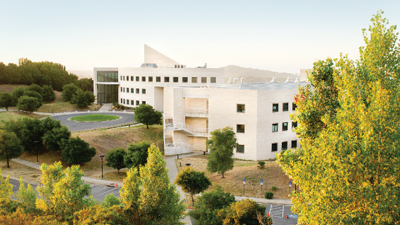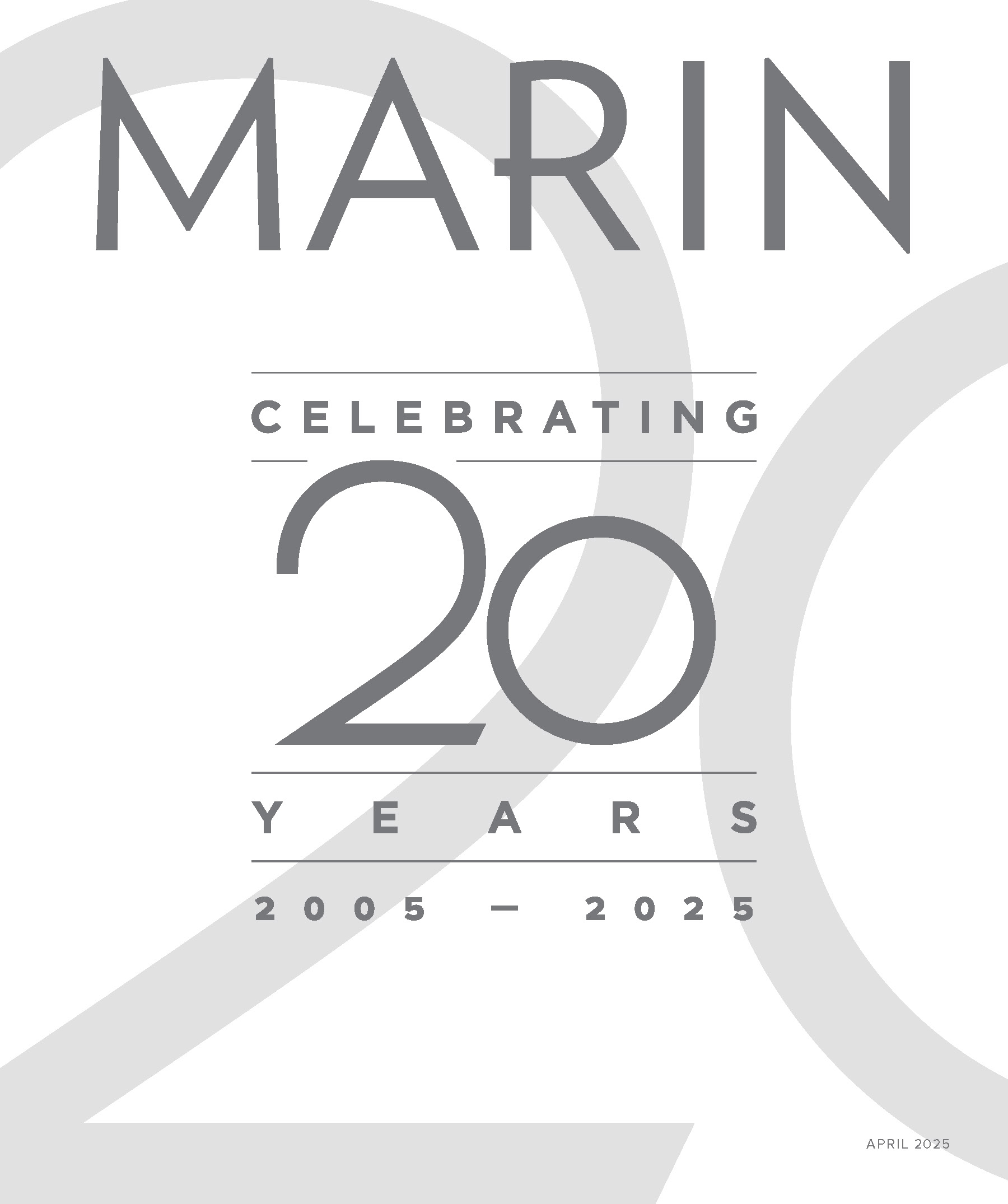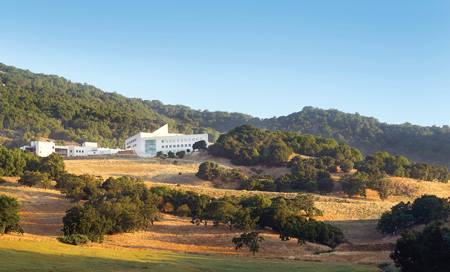Driving just north of Novato on Highway 101 you can’t miss it. It’s the Buck Institute for Research on Aging, that gleaming-white, modernistic building sitting all alone on the flanks of Mount Burdell. With cattle grazing below, it looks so, shall we say, serene. But looks can be deceiving — and in this case, they definitely are.
What’s impossible to see from 101 is the construction of a 66,000-square-foot building that is nearing completion. “This is the second of four research buildings approved in our master plan,” says Kris Rebillot, the Buck Institute’s director of communications. “We hope to start moving in later this year. It will be fully operational by next spring.”
The new $40 million structure — similar in appearance to the two existing I. M. Pei–designed buildings that were completed in 1999 — will house up to 12 laboratories, scientific support space, administrative offices, conference rooms and on-site food service. According to Rebillot, there was only one slight alteration from Pei’s original Buck Institute structures. “Our first buildings feature travertine marble from a quarry in Italy,” she says. “However, this time our vice president of facilities was able to find matching stone from a quarry in Idaho, which dramatically reduced our costs.”
Currently, the Buck Institute’s Novato campus encompasses two buildings totaling 185,000 square feet. “We employ nearly 200 people,” adds Rebillot. “When the new building is fully occupied, that number will jump to almost 330.” In the late 1990s, Pei — the architect for the National Gallery of Art in Washington, D.C., the glass-and-steel “pyramid” for the Louvre museum in Paris and the John F. Kennedy Presidential Library in Massachusetts — provided a “sketch” master plan regarding the Institute’s build-out. “This new building will be number three of a potential five structures,” adds Rebillot.
The Buck Institute is America’s first independent research facility focusing solely on understanding the connection between aging and chronic disease. “Our mission is to increase the healthy years of one’s life,” says its president and CEO, Brian Kennedy, Ph.D. “At a time when people over 65 will soon outnumber children under five, finding a way to slow age-related diseases and disorders and extend productivity must become a priority,” he adds.
 The new facility on the Buck complex, called the Center of Excellence, will focus on regenerative medicine. “We’ll be exploring how to revitalize aging tissues that are losing their capacity to regenerate and trying to understand why stem cells fail to function as one gets older,” says Rebillot. This, she adds, is in addition to current intensive and extensive research involving fruit flies, mice and — are you ready for this? — worms. “Believe it or not, nematode worms are a very popular research model,” she says. “They have a short life span, which allows for quick experiments. At the same time they are genetically similar to humans.” A major thrust of the institute’s work involves slowing, if not eliminating, the effects of both Alzheimer’s and Parkinson’s diseases.
The new facility on the Buck complex, called the Center of Excellence, will focus on regenerative medicine. “We’ll be exploring how to revitalize aging tissues that are losing their capacity to regenerate and trying to understand why stem cells fail to function as one gets older,” says Rebillot. This, she adds, is in addition to current intensive and extensive research involving fruit flies, mice and — are you ready for this? — worms. “Believe it or not, nematode worms are a very popular research model,” she says. “They have a short life span, which allows for quick experiments. At the same time they are genetically similar to humans.” A major thrust of the institute’s work involves slowing, if not eliminating, the effects of both Alzheimer’s and Parkinson’s diseases.
The Buck Institute for Research on Aging operates on an annual budget of $35 million, with 50 percent of that sum coming from federal grants and nearly 34 percent coming from private philanthropy, foundation grants and other sources such as interest and investments. “About 16 percent of our annual revenue, as well as our very name, comes from the Buck Trust,” says Blair Winn, the institute’s director of resource development. “There’s a misconception that because of our name and association with the Buck Trust, public support isn’t necessary,” Winn adds. “But that’s far from the truth. Increasingly we will need the public to join our very public cause if the Center of Excellence is to be successful.”
Being specific, spokesperson Rebillot says that just half of the building’s construction costs are being covered by grant monies. “We received $20.5 million from the California Institute for Regenerative Medicine, or CIRM, which was established in 2004 with the passage of Proposition 71, the California Stem Cell Research and Cures Act,” she says. While bonds have been sold to facilitate construction of the new building, according to both Winn and Rebillot, a capital campaign is currently under way to raise more than $20 million from the community to “retire the bonds and invest in our science.”
The Buck Trust is the legacy of Leonard and Beryl Hamilton Buck, the last of whom passed away in 1975 leaving about $12 million for “charitable purposes in Marin County” including, in Beryl Buck’s words, “extending help to the problems of aging.” Then, over ensuing years, two developments occurred. First, the trust, consisting primarily of a Texas oil company, grew exponentially into one totaling hundreds of millions of dollars. (It’s now approximately $750 million and administered by the Marin Community Foundation.) Second, various legal challenges emerged, including one to break the “Marin-only” caveat.
A 1986 court-approved solution was to distribute 80 percent of the trust’s annual earnings to Marin-specific causes and divide 20 percent of the earnings among three Marin-based organizations that would benefit all humankind. In addition to the Buck Institute for Research on Aging, these include the Buck Institute for Education and the Marin Institute, which deals with alcohol-related problems. In a fortunate turn of events, attorney Mary McEachron, who was instrumental in the 1986 Buck Trust settlement agreement, is now chief administrative officer of the Buck Institute for Research on Aging.
It was McEachron who, in 1985, helped convene a panel of nationwide experts to discuss the creation of a Marin-based freestanding research institute centering on problems facing the aging population. In its final gathering, according to records, the panel challenged the new institute “to become the preeminent research institute on aging; establish for itself a national reputation; and contribute significantly to our (nation’s) ability to reduce disability and dependency in later life.”
In just over a decade, the Buck Institute for Research on Aging, as evidenced by a $20.5 million vote of confidence to build a second research facility, appears well on its way toward fulfilling that lofty mission. Now it’s the community’s challenge to match the grant of the California Institute for Regenerative Medicine. “We are working hard to identify all the sources of funding, thus allowing us to maximize this opportunity that has so much potential for the future health of all of us,” says Kennedy.
Rebillot succinctly puts it this way: “Consider us the Apollo Project of aging.” So, when driving north on 101, don’t let the serene white buildings on the hill — along with the grazing cattle below — deceive you. A lot is going on up there.



